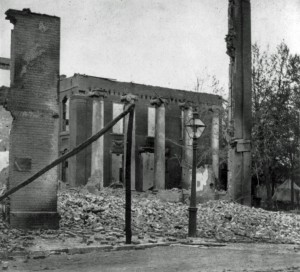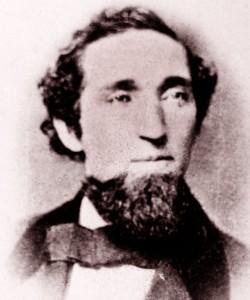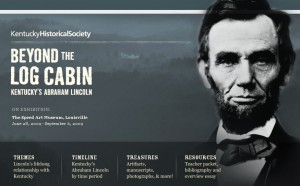 “Beyond the Log Cabin: Kentucky’s Abraham Lincoln” is a great online exhibit created by the Kentucky Historical Society. This interactive site includes manuscripts and artifacts from over 40 repositories nationwide and the content is divided into four overall categories – Themes, Timeline, Treasures, and Resources. Themes include topics such as “Frontier World of Abraham Lincoln,” “Lincoln’s Rise,” “Lincoln and Kentucky at War,” and “Remembering Lincoln: Then and Now.” Each one has a short essay as well as relevant documents, images, and other relevant artifacts. The Timeline section explores Lincoln’s life in Kentucky as well as how the state has commemorated the Sixteenth President after April 1865. The Treasures section allows visitors to explore all of the photographs, manuscripts, and other artifacts in an interactive display. Resources include a Teacher’s guide, a bibliography, and an essay originally published in the Kentucky Historical Society Chronicle.
“Beyond the Log Cabin: Kentucky’s Abraham Lincoln” is a great online exhibit created by the Kentucky Historical Society. This interactive site includes manuscripts and artifacts from over 40 repositories nationwide and the content is divided into four overall categories – Themes, Timeline, Treasures, and Resources. Themes include topics such as “Frontier World of Abraham Lincoln,” “Lincoln’s Rise,” “Lincoln and Kentucky at War,” and “Remembering Lincoln: Then and Now.” Each one has a short essay as well as relevant documents, images, and other relevant artifacts. The Timeline section explores Lincoln’s life in Kentucky as well as how the state has commemorated the Sixteenth President after April 1865. The Treasures section allows visitors to explore all of the photographs, manuscripts, and other artifacts in an interactive display. Resources include a Teacher’s guide, a bibliography, and an essay originally published in the Kentucky Historical Society Chronicle.
15
Nov
10
“Beyond the Log Cabin: Kentucky’s Abraham Lincoln”
Posted by sailerd Published in 19th Century (1840-1880), Historic Periodicals, Images, Letters & Diaries12
Nov
10
Cornelia Peake McDonald Journal
Posted by sailerd Published in Civil War (1861-1865), Letters & Diaries Themes: Women & Families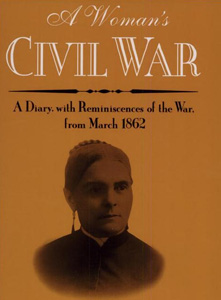 Winchester, Virginia in the Shenandoah Valley was arguably the most contested town of the Civil War. Depending on how you count, the community changed hands over seventy times during four years. Several women kept diaries, wrote remarkable letters or crafted post-war reminiscences. One of the best hybrid collections (part-diary/ part-recollection) comes from Cornelia Peake McDonald who wrote with great talent and behaved with outrageous defiance. After Union soldiers “threatened to come in and break up the furniture if breakfast was not immediately given them,” McDonald and her children prepared to defend their home – McDonald described how they “fastened down the windows and tried… to keep them from coming in at the door.” Raising children in a town like Winchester with lots of soldiers stationed in the vicinity also presented other challenges. After her son was arrested on the suspicion of throwing a snowball at a Union officer, McDonald observed that –
Winchester, Virginia in the Shenandoah Valley was arguably the most contested town of the Civil War. Depending on how you count, the community changed hands over seventy times during four years. Several women kept diaries, wrote remarkable letters or crafted post-war reminiscences. One of the best hybrid collections (part-diary/ part-recollection) comes from Cornelia Peake McDonald who wrote with great talent and behaved with outrageous defiance. After Union soldiers “threatened to come in and break up the furniture if breakfast was not immediately given them,” McDonald and her children prepared to defend their home – McDonald described how they “fastened down the windows and tried… to keep them from coming in at the door.” Raising children in a town like Winchester with lots of soldiers stationed in the vicinity also presented other challenges. After her son was arrested on the suspicion of throwing a snowball at a Union officer, McDonald observed that –
“I have to be constantly on the watch for fear of my boys doing something to provoke the persecution of the Yankees. Not long since I heard an explosion in the yard loud enough to create some alarm, and on hurrying out saw a squad of soldiers approaching the scene of action, thinking it was an alarm. The noise proceeded from a battery the boys had erected on the top of the cistern and had supplied it with guns they had manufactured out of musket barrels cut into lengths of eight or nine inches, and bored for a touch hole, then mounted on carriages of their own make. I had noticed them very busily engaged about the yard for some time but never dreamed what they were after.”
You can read other excerpts from McDonald’s diary on Google Books.
9
Nov
10
Kate Stone Journal
Posted by sailerd Published in Civil War (1861-1865), Letters & Diaries Themes: Slavery & Abolition, US & the World, Women & Families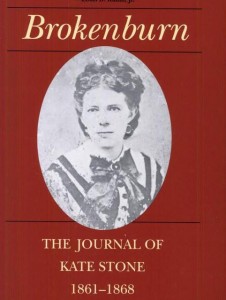 Kate Stone was twenty-years-old when Fort Sumter fell to Confederate forces. She was thrilled. Stone was an ardent southern nationalist from Louisiana who lived on a large plantation (Brokenburn) with many slaves and an extended family, including at least two brother who would die in the Confederate army. Within a month after Sumter, Stone began a diary the she kept for seven years. The material was full of biting insights and wise comments. Stone lived through General Ulysses Grant’s Vicksburg Campaign in 1863 and feared the arrival of black troops into the region. After African Americans entered military service, Stone argued that “the Paternal Government at Washington has done all in its power to incite a general insurrection throughout the South, in the hopes of thus getting rid of the women and children in one grand holocaust.” She and her family fled to Texas in 1863 and lived there until the end of the war. The young plantation mistress was suitably unimpressed by Texans and frontier life. Stone’s sardonic tone appeared frequently in her journal and sometimes was especially hardened. Following Lincoln’s assassination, she remarked on her satisfaction at his fate. “All honor to J. Wilkes Booth, who has rid the world of a tyrant and made himself famous for generations,” she wrote. Stone returned to Brokenburn –which had been devastated by the war—helped rebuild the place, married in 1869 and lived until 1907. When her diary was published in 1955, it was to wide acclaim, hailed by critics such as Edmund Wilson and by crowds –an estimated 10,000 folks in Louisiana including her 77-year-old daughter (who lived until 1972) and has since become regarded as a Civil War classic, though it is not as well known and familiar as Mary Chesnut’s diary.
Kate Stone was twenty-years-old when Fort Sumter fell to Confederate forces. She was thrilled. Stone was an ardent southern nationalist from Louisiana who lived on a large plantation (Brokenburn) with many slaves and an extended family, including at least two brother who would die in the Confederate army. Within a month after Sumter, Stone began a diary the she kept for seven years. The material was full of biting insights and wise comments. Stone lived through General Ulysses Grant’s Vicksburg Campaign in 1863 and feared the arrival of black troops into the region. After African Americans entered military service, Stone argued that “the Paternal Government at Washington has done all in its power to incite a general insurrection throughout the South, in the hopes of thus getting rid of the women and children in one grand holocaust.” She and her family fled to Texas in 1863 and lived there until the end of the war. The young plantation mistress was suitably unimpressed by Texans and frontier life. Stone’s sardonic tone appeared frequently in her journal and sometimes was especially hardened. Following Lincoln’s assassination, she remarked on her satisfaction at his fate. “All honor to J. Wilkes Booth, who has rid the world of a tyrant and made himself famous for generations,” she wrote. Stone returned to Brokenburn –which had been devastated by the war—helped rebuild the place, married in 1869 and lived until 1907. When her diary was published in 1955, it was to wide acclaim, hailed by critics such as Edmund Wilson and by crowds –an estimated 10,000 folks in Louisiana including her 77-year-old daughter (who lived until 1972) and has since become regarded as a Civil War classic, though it is not as well known and familiar as Mary Chesnut’s diary.
27
Oct
10
As the 150th anniversary of the 1860 election is next week, the House Divided project has just published seven interactive essays at Journal Divided that focus on different aspects of Abraham Lincoln’s campaign. These essays have been adapted with permission from the unedited manuscript of Michael Burlingame’s Abraham Lincoln: A Life (2008). One can read about the origins of the “rail-splitter” image and Lincoln’s efforts to gain support from the Know Nothings. In addition, one will find an overview of the Republican National Convention as well as a detailed look at how Lincoln won the nomination. While Lincoln instructed his allies at the convention to “make no contracts that will bind me,” Burlingame discusses the contradictory claims and evidence about the deals made to secure Lincoln’s nomination. In the final essay Burlingame examines the political conditions that produced a Republican victory in November 1860. As you read the essays, be sure to click through the sidenotes on every page. These contain links to relevant records on House Divided, including those for documents, events, people, place, major topics, and sources. For example, the Gott resolution is mentioned on page 5 of the “Lincoln Know Nothing” essay. If you are unfamiliar with that topic, simply click on the “Events” sidenote to learn more. Each essay also has a video, which you can watch by clicking on the YouTube icon.
8
Oct
10
Burning of Chambersburg, PA (July 1864)
Posted by sailerd Published in Civil War (1861-1865), Historic Periodicals, Images, Letters & Diaries, Maps Themes: Battles & SoldiersOn July 30, 1864 Confederate cavalry under General John McCausland’s command entered Chambersburg, Pennsylvania and demanded that residents pay $500,000 in greenbacks or $100,000 in gold. Confederates planned to use the money to compensate Virginia residents whose homes in the Shenandoah Valley were burned by Union General David Hunter’s troops. After Chambersburg residents refused to pay, General McCausland followed General Jubal Early’s orders and burned the town. (this map shows which sections of the town were burned). General McCausland’s forces left the following day with Union cavalry in pursuit. Philadelphia resident Sidney George Fisher heard about the attack on August 1st. Confederates, as Fisher noted, had “set fire to the place without giving the people time to carry anything away.” Fisher believed that the Confederate actions were the results of the “prolonged” conflict. “The barbarous act shows what a bitter spirit is animating the contest,” as Fisher explained. The Bangor (ME) Whig and Courier, a Republican paper, also expressed “[sympathy for] the suffers at Chambersburg.” Yet “if the atrocious outrage shall awake Pennsylvania to the performance of duties she has long and shamefully neglected in her own defense,” the editor argued that this incident “will in the end prove to be one of the greatest blessings which has been vouchsafed us since the war began.” You can learn more about this attack in Benjamin Schneck’s The Burning of Chambersburg (1864) and Everard H. Smith’s “Chambersburg: Anatomy of a Confederate Reprisal,” American Historical Review (1991).
24
Sep
10
Election of 1860 – Ulysses S. Grant
Posted by sailerd Published in Antebellum (1840-1861), Images, Letters & Diaries Themes: Contests & Elections The Ulysses S. Grant Association at Mississippi State University has digitized all 31 volumes included in the Papers of Ulysses S. Grant. This project also offers a chronology and a nice collection of images. In August 1860 Grant observed that “the Democratic party want a little purifying and nothing will do it so effectually as a defeat.” However, Grant did not want Abraham Lincoln to win in November 1860. “The only thing is dont like to see a Republican beat the [Democratic] party,” as Grant explained. After Lincoln won the election, Grant could not believe that southern Democrats would accept secession. “It is hard to realize that a State or States should commit so suicidal an act as to secede from the Union,” as Grant noted. You can learn more about Grant’s career in William S. McFeely’s Grant: A Biography (1981) and Jean Edward Smith’s Grant (2001). Brooks Simpson focuses on Grant’s role during the Civil War and Reconstruction in Let Us Have Peace: Ulysses S. Grant and the Politics of War and Reconstruction, 1861-1868 (1991).
The Ulysses S. Grant Association at Mississippi State University has digitized all 31 volumes included in the Papers of Ulysses S. Grant. This project also offers a chronology and a nice collection of images. In August 1860 Grant observed that “the Democratic party want a little purifying and nothing will do it so effectually as a defeat.” However, Grant did not want Abraham Lincoln to win in November 1860. “The only thing is dont like to see a Republican beat the [Democratic] party,” as Grant explained. After Lincoln won the election, Grant could not believe that southern Democrats would accept secession. “It is hard to realize that a State or States should commit so suicidal an act as to secede from the Union,” as Grant noted. You can learn more about Grant’s career in William S. McFeely’s Grant: A Biography (1981) and Jean Edward Smith’s Grant (2001). Brooks Simpson focuses on Grant’s role during the Civil War and Reconstruction in Let Us Have Peace: Ulysses S. Grant and the Politics of War and Reconstruction, 1861-1868 (1991).
24
Aug
10
Union Soldiers – Cumberland County, Pennsylvania
Posted by sailerd Published in Civil War (1861-1865), Letters & Diaries, Recent Scholarship Themes: Battles & Soldiers, Carlisle & Dickinson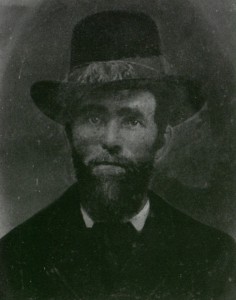
John Cantilion
The House Divided project received permission from the Cumberland County Historical Society to post articles that explore topics related to the Civil War era in Cumberland County, Pennsylvania. These essays originally appeared in the Cumberland County History Journal. Right click on the links below and select “save as” to download the article as a PDF file. (Adobe Reader is a free program that is required to vide these documents).
Patricia Coolmeyer, “Southern Sentiments: A Look at Attitudes of Civil War Soldiers ,” Cumberland County History 7 (1990): 68-79.
- Patricia Coolmeyer’s essay explores the different ways that soldiers and residents of southern Pennsylvania saw the South during the Civil War. Coolmeyer uses a wide variety of sources in her account, including letters, diaries, local newspapers, and other nineteenth-century publications.
James A. Holechek, “From Carlisle and Fort Couch: The War of Corporal John Cantilion,” Cumberland County History 10 (1993): 71-80.
- James A. Holechek’s article focuses on Corporal John Cantilion’s experiences in central Pennsylvania during the summer of 1863. Cantilion served in the 4th United States Cavalry and was stationed at Carlisle Barracks in early June 1863. This essay includes transcripts of letters that Cantilion wrote from Carlisle Barracks on June 19 and from Fort Couch on June 23. Holechek also provides the transcript of a letter that Cantilion’s wife, Sarah, wrote in early November 1863. However, Cantilion died on November 12, 1863 and never received that letter. In addition, photographs of John and Sarah Cantilion are reproduced in this essay.
17
Aug
10
Battle of Sporting Hill – June 30, 1863
Posted by sailerd Published in Civil War (1861-1865), Letters & Diaries Themes: Battles & SoldiersThe Battle of Sporting Hill, which was part of the Gettysburg Campaign, took place on June 30, 1863 in Camp Hill, Pennsylvania between elements of the 16th Virginia Calvary Regiment and two New York Militia Regiments. The Confederate forces at Sporting Hill served as a rearguard for General Albert G. Jenkins, whose brigade was stationed several miles away in Mechanicsburg. Early on June 30, however, Jenkins moved out after he received General Robert E. Lee’s order to regroup at Gettysburg. The 22nd and 37th New York Militia Regiments, which were under the overall command of General Darius N. Couch, were out on reconnaissance when they engaged Jenkins’ rearguard. (Union General William F. Smith had ordered a patrol once he realized that Confederates were withdrawing from the area). As John Lockwood recalled, the two New York regiments were:
“ordered out to reconnoiter. Expecting to return in course of the day left everything behind except arms and ammunition and thus passed through rest of campaign! They moved along the Carlisle road to ‘Sporting Hill’ where had a skirmish.”
Union forces forced Confederates to withdraw after they brought in a detachment from Landis’ Philadelphia Battery of Light Artillery, but they were unable to pursue them. Reports indicated that approximately sixteen soldiers died during the engagement. A historical marker is located at the intersection of 31st Street and Market Streets in Camp Hill. You can read more about this battle in an essay on ExplorePAhistory.com, Robert Grant Crist’s article “Highwater 1863: The Confederate Approach to Harrisburg” (Pennsylvania History 1963), and in Wilbur Sturtevant Nye’s Here Come The Rebels! (1965).
30
Jul
10
Confederate raid on Chambersburg, Pennsylvania (October 1862)
Posted by sailerd Published in Civil War (1861-1865), Historic Periodicals, Images, Letters & Diaries Themes: Battles & Soldiers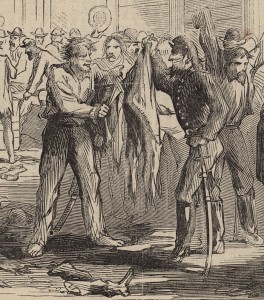 Before going to bed on October 10, 1862, Chambersburg resident William Heyser noted in his diary that he had “secreted some of my most valuable papers.” Confederate cavalry under the command of General J. E. B. Stuart had arrived several hours earlier and forced the town to surrender. Union forces had been caught by surprise and none were available to defend the town. “It would have been an act of madness to have made resistance…and would have involved the total destruction of the town,” as the Chambersburg (PA) Valley Spirit noted. The raid, as the Milwaukee (WI) Sentienel described, “was the most daring adventure of the war” so far. Besides gathering intelligence, one of the Confederate’s other objectives was to take as many supplies as possible. Horses were one key item and Alexander Kelly McClure, an assistant adjutant Union general, later recalled how ten horses were taken from his farm. (You can read McClure’s full account of the Confederate raid – “A Night With Stuart’s Raiders”- here). Yet as one Confederate soldier’s letter revealed, they also seized a number of other supplies. “I got 8 pair of boots, 4 over coats, 5 pair of pantaloons, 2 hats, 6 pair of socks, 6 pr. Draws, 6 over & under shirts, [and] some coffe & sugar” during the raid, as Edward Cottrell told his grandmother. As Confederates left Chambersburg on October 11, they burned warehouses that held government supplies. One contained ammunition and, as Heyser described, “the succeeding explosions of shells and power was tremendous.” While Union forces were dispatched to intercept and capture the raiders, General Stuart evaded them and returned to Virginia without any major engagements. You can read more about the raid in Emory M. Thomas’ Bold Dragoon: The Life of J.E.B. Stuart (1986) and Jeffry D. Wert’s Cavalryman of the Lost Cause: A Biography of J. E. B. Stuart (2008).
Before going to bed on October 10, 1862, Chambersburg resident William Heyser noted in his diary that he had “secreted some of my most valuable papers.” Confederate cavalry under the command of General J. E. B. Stuart had arrived several hours earlier and forced the town to surrender. Union forces had been caught by surprise and none were available to defend the town. “It would have been an act of madness to have made resistance…and would have involved the total destruction of the town,” as the Chambersburg (PA) Valley Spirit noted. The raid, as the Milwaukee (WI) Sentienel described, “was the most daring adventure of the war” so far. Besides gathering intelligence, one of the Confederate’s other objectives was to take as many supplies as possible. Horses were one key item and Alexander Kelly McClure, an assistant adjutant Union general, later recalled how ten horses were taken from his farm. (You can read McClure’s full account of the Confederate raid – “A Night With Stuart’s Raiders”- here). Yet as one Confederate soldier’s letter revealed, they also seized a number of other supplies. “I got 8 pair of boots, 4 over coats, 5 pair of pantaloons, 2 hats, 6 pair of socks, 6 pr. Draws, 6 over & under shirts, [and] some coffe & sugar” during the raid, as Edward Cottrell told his grandmother. As Confederates left Chambersburg on October 11, they burned warehouses that held government supplies. One contained ammunition and, as Heyser described, “the succeeding explosions of shells and power was tremendous.” While Union forces were dispatched to intercept and capture the raiders, General Stuart evaded them and returned to Virginia without any major engagements. You can read more about the raid in Emory M. Thomas’ Bold Dragoon: The Life of J.E.B. Stuart (1986) and Jeffry D. Wert’s Cavalryman of the Lost Cause: A Biography of J. E. B. Stuart (2008).
24
Jul
10
The Courtship of James Garfield
Posted by hardyr Published in Antebellum (1840-1861), Letters & Diaries Themes: Education & Culture, Women & Families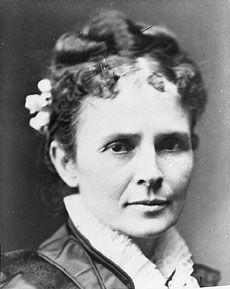 In 1847, Zeb and Arabella Rudolph decided that their daughter Lucretia needed more of an academic challenge than the local Garrettsville, Ohio, schools could offer. The fifteen-year old was sent twenty miles away to board at the Geauga Seminary, where she would have the benefit of a classical curriculum. The Geauga Seminary was coeducational, and one of Lucretia’s fellow pupils there was an awkward and earnest sixteen-year old boy named James Garfield.
In 1847, Zeb and Arabella Rudolph decided that their daughter Lucretia needed more of an academic challenge than the local Garrettsville, Ohio, schools could offer. The fifteen-year old was sent twenty miles away to board at the Geauga Seminary, where she would have the benefit of a classical curriculum. The Geauga Seminary was coeducational, and one of Lucretia’s fellow pupils there was an awkward and earnest sixteen-year old boy named James Garfield.
“A prodigy,” Lucretia called him.
In 1850, Lucretia left the Geauga Seminary and enrolled in the new Hiram Eclectic Institute in Hiram, Ohio. The following year, Garfield also enrolled at Hiram, and Lucretia experienced the unexpected thrill of meeting “a pair of eyes…as once I looked up from a hard sentence somewhere in the fore part of the Greek grammar.” It wasn’t exactly love at first conjugation—both she and James were recovering from painful break-ups—but in 1853 James surprised Lucretia with a letter written during an excursion to Niagara Falls, and soon the two were engaged in a full-fledged correspondence.
At first, they addressed each other as Brother and Sister. They wrote about the books they were reading, and about their shared enthusiasm for teaching. James was teaching Latin and Greek at Hiram, and Lucretia was teaching at a public school in Chagrin Falls, and attempting to keep pace with James’s Latin class in reading Virgil.
“I would like to know how many hundred lines the Virgil class are ahead of me,” she wrote to James in November 1853.
“Today, the Virgil class finished the third book and are going about 50 lines per day,” Jame wrote back on December 8. “Are you ahead? I presume so. Won’t you come in to both Greek and Latin in the spring? We miss you very much in these two classes. What are your views with regard to studying the classics? Have you reconciled yourself to devoting a few more years to them? I would like to hear your reasonings on the subject.”
Replying six days later, Lucretia confessed that she had laid aside Virgil for the winter. As to the study of classics in general, she wrote: “Candidly, I will confess that thus far I have prosecuted the study of them without any argument in their favor which appeared to me conclusive.” She admitted that the study of Greek and Latin provided “rigid mental discipline,” but she wondered if there might be other means of acquiring that discipline.
“I wish you would convince me of their superior merit if they really possess it,” she wrote; “for I do not like to give them up—neither do I like to continue in them feeling that precious moments are being wasted…”
This discussion continued in several letters over the following months. Meanwhile, James quietly dropped the pretense of calling her Sister, and soon Lucretia was sending James her “warmest love.” In March 1854, the subject of marriage was raised.
James A. Garfield—veteran of Shiloh and Chickamauga, Union general, and twentieth President of the United States—courted his wife with a debate over the value of a classical education.
The correspondence of James and Lucretia Garfield can be found in John Shaw, ed. Crete and James: Personal Letters of Lucretia and James Garfield (Michigan State University Press 1994). For a biography of Lucretia Garfield, see John Shaw, Lucretia (Nova History Publications, 2001). On James Garfield’s study of the classics, see Susan Ford Wiltshire’s essay, “The Classicist President” (.pdf).

